Phosphorus removal in vertical flow reed beds using baked clay balls as an alternative media
Prashant * , Ankita Jyoti , Shubham Kumar , Faiz Ahmad Siddiqui , Rachana Singh and Subodh Kumar
Corresponding author Email: drprashant@cub.ac.in
DOI: http://dx.doi.org/10.12944/CWE.17.1.21
Phosphorous (P) entering into the water bodies through point and non-point sources is a causal agent for eutrophication. Nature Based Solutions (NBS) like Constructed Wetlands (CW) are cost effective methods for treating the grey waters in order to protect the water bodies form risk of eutrophication. The P removal efficiency of Constructed Wetlands (CW) can be improved by adding new substrate having potential P removal efficiency.The study was conducted to determine the phosphorus removal from wastewater using Baked Clay Ball (BCB) media in Vertical Flow Reed Beds (VFRB). The BCB was prepared with a mixture of river clay and saw dust. The field and lab-scale experimentation were set and operated in batch feeding mode using institutional wastewater for four months. The VFRBs were filled with BCB and planted with locally available reed grass (Phragmites karka). The hydraulic retention period in VFRB was 48 hours. Prime goal of the experiment was to investigate the Phosphorus (P) removal efficiency of the VRFBs apart from other conventional wastewater quality parameters. The concentration of phosphorus of the institutional wastewater was in the range of 27.3 mg/l to 16.3 mg/l. The average phosphorus removal efficiency of the VFRB 1 and 2 filled with BCB was 93.47%, while the average P removal efficiency of gravel filled VFRB 2 and 3 was 68.20%. Thus the experiment reflected that the BCB is a better media than the gravel for P removal. Therefore, the BCB may be used at a field scale to remove P from wastewater in constructed wetlands.Further, there is scope to develop new substrate materials focusing on its P retention capacity, long lasting performance and cost of the substrate to be applied in real treatment situations.
Copy the following to cite this article:
Prashant P, Jyoti A, Kumar S, Siddiqui F. A, Singh R, Kumar S. Phosphorus removal in vertical flow reed beds using baked clay balls as an alternative media. Curr World Environ 2022;17(1). DOI:http://dx.doi.org/10.12944/CWE.17.1.21
Copy the following to cite this URL:
Prashant P, Jyoti A, Kumar S, Siddiqui F. A, Singh R, Kumar S. Phosphorus removal in vertical flow reed beds using baked clay balls as an alternative media. Curr World Environ 2022;17(1).
Download article (pdf)
Citation Manager
Publish History
Select type of program for download
| Endnote EndNote format (Mac & Win) | |
| Reference Manager Ris format (Win only) | |
| Procite Ris format (Win only) | |
| Medlars Format | |
| RefWorks Format RefWorks format (Mac & Win) | |
| BibTex Format BibTex format (Mac & Win) |
Article Publishing History
| Received: | 11-01-2022 |
|---|---|
| Accepted: | 08-04-2022 |
| Reviewed by: | 
 Eric Danso-Boateng
Eric Danso-Boateng
|
| Second Review by: |

 Kosar Hama Aziz
Kosar Hama Aziz
|
| Final Approval by: | Dr Gopal Krihan |
Introduction
Constructed Wetlands (CW) are eco-technology based methods for wastewater treatment. The vegetation, substrate, biofilm and microorganisms of CWs work in co-action to remove a various pollutants from the wastewater.1,2CWs have gained popularity across the world. These systems are widely applied to treatmunicipal sewage, dairy effluents, agricultural runoff and landfill leachates.3–6 Among the four major classes of CWs the vertical flow constructed wetlands (VFCW) are chiefly being used for its smaller size and oxygen diffusing properties.7Phosphorus contamination exists in aqueous wastes of many domestic and agriculture wastewaters.8Phosphorus is a nutrient used by many industries and can be found in many products (a variety of cleaners) used by humans. Therefore, it is one of the main contaminants found in wastewaters.9,10Phosphorus (P) and Nitrogen (N) are major point and non-point sources of pollution causing eutrophication of water bodies.11P tends toattract towards soil and sediments of the receiving water bodies, so it gets accumulated in the system over time.12It causes excessive growth of algae and cyanobacteria, leading to blooms, hypoxia, and a foul-smelling environment in the water bodies under hot climatic conditions.13CWs can be used as a potential wastewater treatment technology in urban, peri-urban and rural areas. The enhanced P removal efficiencies of the CWs can address the eutrophication problems.CWs have been evaluated for removal of phosphorus (P) nitrogen (N) from wastewater.14,15 The filter media of the CWs show P removal due to its sorption capacities, P removals have been evaluated in CWs with sand, soil, marble and calcite.16The most commonly used substrate in CW is gravel. Still the studies have suggested that gravel is not a good choice for P removal.17,18To achieve substantial phosphorus removal it is necessary to select materials with high P adsorption capacity.19The adsorption process has been tested for dyes also.20The focus of the present study was to investigate the efficiency of vertical flow reed beds (VFRBs) for P removal using artificial baked clay balls and natural gravel.The present study focused on investigating the efficiency of vertical flow reed beds (VFRBs) for P removal using artificial baked clay balls and natural gravel.There are methods like membrane separation and ion exchange to remove P from wastewater. Still, in the coming future, the nature-based, phyto-mediated processes will gain momentum in the research and development of new technologies for P removal from wastewater.2120The natural substrate materials can be used in CW without processing. Still, synthetic materials have shown promising results in removing various pollutants like hazardous organic pollutants. 22
Materials and Methods
In order to study the performance of two different types (Baked Clay Balls and Gravel) of filter media for phosphorus reduction in wastewater, an onsite mesocosm level VFRBs were used.
Site description and Experimental design
The experimental set-up was installed near the open sewage drain of Central University of South Bihar, Patna. In the present study,four VFRB were designed, round plastic containers (depth 100 cm, diameter 34 cm) of 65.6 litres was used to prepare the tankage of VFRBs. Two (VFRB-1 and VFRB-2) systems were filled with baked clay ball (BCB) and other two was filled with gravel (VFRB- 3 and VFRB -4). All the CWs were planted with common reed (Phragmites karka) available in the region collected from the banks of river Ganga and cultivated in nursery. Phragmites has shown promising pollution reduction in other experiments conduction in subtropical Indian climatic conditions.23
The VFRBs were loaded with 12 litres of wastewater emanating from the University campus in batch mode at the interval of two days with the help ofa dosing bucket. The bottom of the container was fitted with a tap to collect the treated water from the outlet. The hydraulic retention time (HRT) was kept 48 hours by allowing the wastewater to remain in the VFRBs for two days. The long open sewage grain itself worked as a sedimentation basin. Five plants of Phragmities species were planted at the top of container of an average root length of 62.4 ±5.55 cm and shoot length of 74.3±4.38 cm (figure 1).The dense stand of the vegetation was stored in a month time. During that period the wastewater was applied to the VFRB on a periodic basis. After one month, the wastewater was loaded with the specified HRT at two days.
 |
Figure 1: Schematic representation of VFRB experimentation |
Media selection and preparation
In this experimental setup, two media types were selected to be tested for P removal. Two VFRB cells/containers were filled up to the depth of 60 cm by locally available river bed gravel (figure 2) and other two with BCB.These VFRBs were separate experiments not connected in series. The experimental design used two replicates VFRBs to validate the results. The gravel size was kept at20 mm with 40% porosity. Another media (BCB) was artificially prepared in the laboratory. The constituents of BCB were Ganga river clay (that is rich in Ca) and saw mill dust.24The clay used in present study has been primarily dominated by mica, kaolinite, chlorite, smectite and vermiculite.25Dough of river clay and saw mill dust (6:1) was prepared with adequate amount of distilled water. Small balls of 20 mm size were prepared from the dough. BCBs (figure 2) were first solar dried for threedays, and then it was baked in muffle furnace in the laboratory at 900ºC for five hours. The baking at high temperature caused burning of the saw mill dust particles resulting into a porous BCB. The prepared BCB was then cooled down at room temperature. It was soaked in the distilled water overnight and then solar dried after cooling.
 |
Figure 2: (a). Gravel media and (b). Backed clay balls (BCB) . Click here to view Figure |
Performance monitoring
Samples were collected in 1 litre plastic bottle on weekly basis from the inlet and outlet of the VFRBs, for the purpose of analysis. The collected samples were stored at 4ºC for further analysis in laboratory. A pre-calibrated electronic desktop pH-meter was used for the analysis of pH collected samples. The proportions of total suspended solids (TSS) were estimated by passing 50 ml sample through pre-weighted glass fiber filter papers using the filtration assembly. Final weight of the filter paper was taken after heating it at 103°C. TSS (mg/L) was calculated using the formula below.

(A= final weight of filter paper with dried residue, mg, and, B = pre-weight of filter, mg)
The analysed wastewater quality parameters with standard methods are presented in table 1. The pollution reduction efficiency for Phosphorus, BOD and TSS was estimated for all the VFRBs by comparing the inlet and outlet concentration of wastewater quality parameters as mention in the formula.26
Table 1: Methods used for analysing the samples
|
S.No. |
Parameters |
Method |
|
1. |
pH |
Portable pH meter |
|
2. |
TSS |
Method 2540 D, APHA, 21st Edition, 2005 |
|
3. |
BOD5 |
Method 5210 B, APHA, 21st Edition, 2005 |
|
4. |
Total Phosphorus |
Method 4500 P, APHA, 21st Edition, 2005 |
Pollutant reduction efficiency (%) =

(Ci = concentration of pollutant at inlet in mg/L, Co = concentration of pollutant at outlet in mg/L)
Results
The pH of the institutional wastewater at the inlet during the entire experimental period was in the range of 6.80 -7.69. The pH at the outlet in VFRB-1, 2, 3 and 4 was in the range of 6.54 -7.58, 6.81 -7.43, 6.78-7.53 and 6.77 -7.44, respectively. The mean pH at the inlet was recorded as 7.35± 0.24 and the mean pH at the outlet of VFRB-1, 2, 3, 4 was 7.14 ± 0.26, 7.12 ± 0.16, 7.22 ± 0.20, 7.23 ± 0.18. P removal with different types of slag experimented at the near-neutral range of pH that demonstrated good results in P reduction.27Constructed Wetlands are efficient in theremoval of Total Suspended Solids (TSS),28sedimentation is one of the key processes involved in the retention of TSS associated with P. The settling of the suspended particles by the action of gravity into the bottom and filter media in CW is termed as sedimentation. In the present study mean TSS(mg/L) in the inlet wastewater was 923.48± 138.72. The mean TSS(mg/L) at the outlet of VFRB-1 was 356.79 ± 93.45; VFRB-2, 341.03 ± 83.46; VFRB -3, 306.79 ± 61.26 and VRFB – 4, 301.68 ± 61.06 (figure 3). Mean TSS removal as recorded in VFRB-1 was 61.5 ±6.84%; VFRB-2, 63.1 ±5.78%; VFRB-3, 66.5 ±5.95% and VFRB- 4, 66.8 ±7.29% (figure 4). The mean P in the inlet wastewater was 22±3.42 mg/L. The P at the outlet of the VFRB-1 and VFRB-2 was in the range of 0.9-3.1 mg/L and 1.1- 2.9 mg/L, respectively. The mean P concentration at the outlet of VFRB-1 was 1.7±0.59 mg/L and at theoutlet of VFRB-2 was 1.7±0.57 mg/L (figure 5). The mean P removal from VFRB-1 and VFRB-2 was 92.3±2.28% and 92.4±2.24% (figure 6). In the gravel bed, VFRB-3 and 4, P concentrations at the outlet was 4.6 mg/l to 10.1 mg/l and 4.9mg/l to 9.2mg/l, respectively (figure 5). The mean P concentration at the outlet of the VFRB-3 and VFRB-4 was 6.6±1.5 mg/l and 6.63±1.48 mg/l witha P removal efficiency of 69.6±6.8% and 69.2±7.71%, respectively. The results evidenced that the BCB efficiency in P removal is better than the gravel (figure 6). The BOD5 at the inlet was in the range of 113.7 mg/l – 146mg/l. The BOD5 removal efficiency in VFRB-1, VRFB-2 was recorded as 59.2±3.4% and 62.5±3.19%, respectively. In the gravel bed VFRB-3 and VFRB-4, the BOD5 removal was 67.1±4.79% and 69.8±5.74%, respectively.
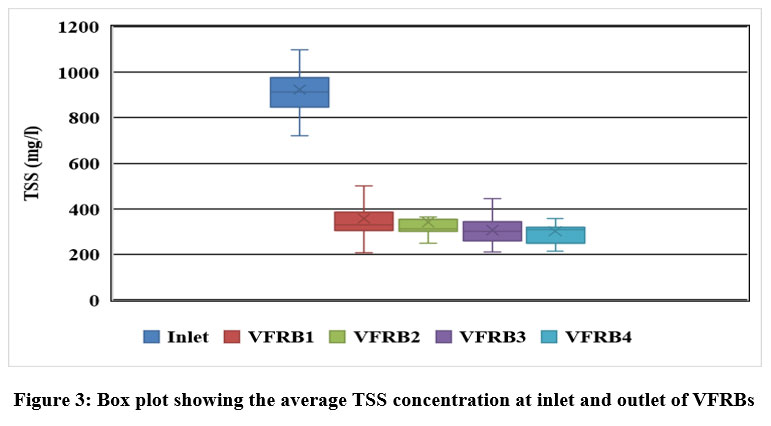 |
Figure 3: Box plot showing the average TSS concentration at inlet and outlet of VFRBs Click here to view Figure |
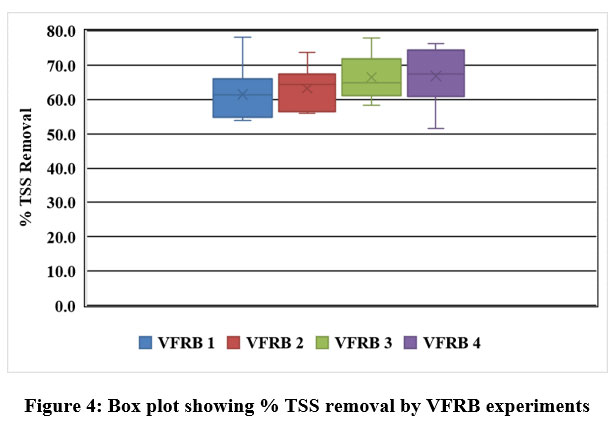 |
Figure 4: Box plot showing % TSS removal by VFRB experiments |
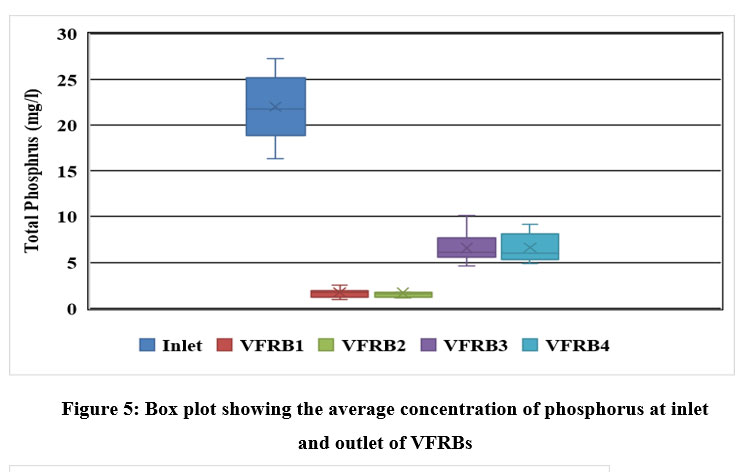 |
Figure 5: Box plot showing the average concentration of phosphorus at inlet |
 |
Figure 6: Box plot showing % Phosphorus removal by VFRB experiments |
 |
Figure 7: Box plot showing the average concentration of BOD5 at inlet and outlet of VFRBs Click here to view Figure |
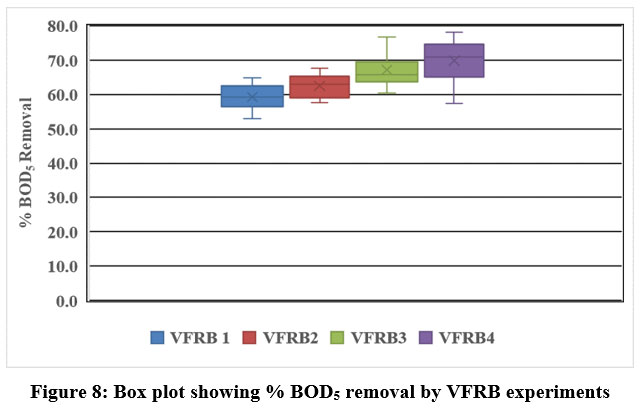 |
Figure 8: Box plot showing % BOD5 removal by VFRB experiments. |
Discussion
Phosphorus is a major pollutant causing eutrophication, so, it’s removal from wastewater using natural systems is attracting research interests.Even the low concentrations of P (< 10mg/l) are sufficient to trigger algal blooms.29TP content in the untreated wastewater was fluctuated between 16.3mg/l to 27.3 mg/l. The reasons for TPatthe inlet were wastewater from hostel kitchens, laboratories, and floor cleaning, bathing and washing.Studies have reported that CWs have been used for removal of P from grey waters. It has been established that the P removal in CWs are due to plant uptake, wetlands soil, microbes, precipitation in standing waters and retention in the media (Figure 9). However, the media plays a substantial role in P removal.30In the present study P removal efficiency was estimated inthe range between 87.2% - 95.7% in BCB filled VFRBs. The main phosphorus removal mechanisms are adsorption and precipitation reactions with Ca, Al, and Fe.31For domestic wastewater treatment in Turkey, the TP removal efficiency for gravel was reported only 4% in vertical subsurface flow constructed wetlands.32 In another study, a low P removal (20%) was reported using gravel in CWs.29In a before and after treatment study it was reported that the blast furnace slag (98% removal) show similar results as BCB at a low (3mg/l) TP concentration.33 Newer substrates like fragmented limestone demonstrated an average P removal of 67% that is lower than the BCB in a mesocosm level study.34The fly as ceramics also has equal potential (90% P removal) for P removal as BCB in the present study.35
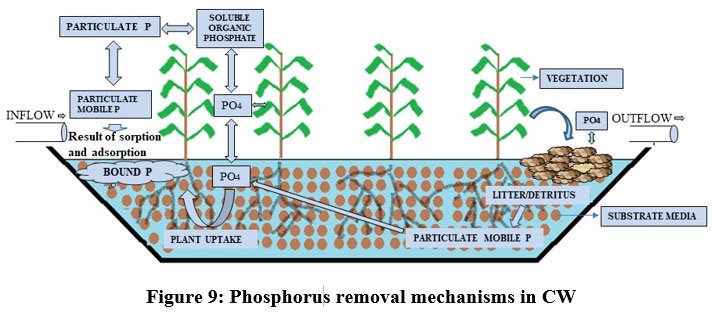 |
Figure 9: Phosphorus removal mechanisms in CW Click here to view Figure |
Conclusion
VFRBs filled with gravel and BCB, planted with Phragmiteswere tested for P removal at the mesocosm level. The highest TP removal was recorded in VFRB-1 (92.4%) > VFRB-2 (92.3%) > VFRB-3 (69.6%) > VFRB-4 (69.2%) in the present experimental work. The VFRB-1 and 2 exhibited the highest P removal that was filled with the BCB substrates made up of clay and saw mill dust, making it porous, providing active surface activity of P. Based on the study, it is recommended that BCB can serve as better substrate for P removal in vertical flow constructed wetlands. Further, there is scope to develop new substrate materials focusing on its P retention capacity, long lasting performance and cost of the substrateto be applied in real treatment situations.
Acknowledgement
The author would like to thank Department of Environmental Science, Central University of South Bihar, Gaya, for providing the laboratory facilities for testing of samples and space to carry out the experimental work.
Conflict of interest
The authors do not have any conflict of interest.
Funding Sources
There is no funding or financial support for this research work.
References
- Vymazal J. Removal of nutrients in various types of constructed wetlands. Sci Total Environ. 2007;380(1-3):48-65. doi:10.1016/J.SCITOTENV.2006.09.014
- Geranmayeh P, Johannesson KM, Ulén B, Tonderski KS. Particle deposition, resuspension and phosphorus accumulation in small constructed wetlands. Ambio. 2018;47:134-145. doi:10.1007/s13280-017-0992-9
- Branchu P, Gres L, Mougin F, Le Blanc M, Lucas E, Mars B. French airport runoff pollution management (water and sludge): toward a new approach based on constructed wetlands? Case of Aéroports de Paris – Orly (France). Water Pract Technol. 2014;9(1):20-32. doi:10.2166/WPT.2014.003
- Pelissari C, Sezerino PH, Decezaro ST, et al. Nitrogen transformation in horizontal and vertical flow constructed wetlands applied for dairy cattle wastewater treatment in southern Brazil. Ecol Eng. 2014;73:307-310. doi:10.1016/J.ECOLENG.2014.09.085
- Bakhshoodeh R, Alavi N, Oldham C, et al. Constructed wetlands for landfill leachate treatment: A review. Ecol Eng. 2020;146:105725. doi:10.1016/J.EcolEng.2020.105725
- Sharma PK, Takashi I, Kato K, Ietsugu H, Tomita K, Nagasawa T. Seasonal efficiency of a hybrid sub-surface flow constructed wetland system in treating milking parlor wastewater at northern Hokkaido. Ecol Eng. 2013;53:257-266. doi:10.1016/J.ECOLENG.2012.12.054
- Stefanakis A, Akratos CS, Tsihrintzis VA. Vertical Flow Constructed Wetlands: Eco-Engineering Systems for Wastewater and Sludge Treatment. 1st ed. Elsevier; 2014. doi:10.1016/C2012-0-01288-4
- Tong Y, Zhang W, Wang X, et al. Decline in Chinese lake phosphorus concentration accompanied by shift in sources since 2006. Nat Geosci 2017 107. 2017;10(7):507-511. doi:10.1038/ngeo2967
- Elser JJ. Phosphorus: a limiting nutrient for humanity? Curr Opin Biotechnol. 2012;23(6):833-838. doi:10.1016/J.COPBIO.2012.03.001
- Zhao XH, Zhao YQ. Investigation of phosphorus desorption from P-saturated alum sludge used as a substrate in constructed wetland. Sep Purif Technol. 2009;66(1):71-75. doi:10.1016/J.SEPPUR.2008.11.020
- Conley DJ, Paerl HW, Howarth RW, et al. Ecology - Controlling eutrophication: Nitrogen and phosphorus. Science (80- ). 2009;323(5917):1014-1015. doi:10.1126/science.1167755/asset/c24926ec-b7fd-4441-8563-ce13005f4587/assets/science.1167755.fp.png
- Carpenter SR. Phosphorus control is critical to mitigating eutrophication. Proc Natl Acad Sci. 2008;105(32):11039-11040. doi:10.1073/PNAS.0806112105
- Correll DL. The Role of Phosphorus in the Eutrophication of Receiving Waters: A Review. J Environ Qual. 1998;27(2):261-266. doi:10.2134/JEQ1998.00472425002700020004X
- Brix H, Arias CA. The use of vertical flow constructed wetlands for on-site treatment of domestic wastewater: New Danish guidelines. Ecol Eng. 2005;25(5):491-500.
- Koottatep T, Polprasert C. Role of plant uptake on nitrogen removal in constructed wetlands located in the tropics. Water Sci Technol. 1997;36(12):1-8. doi:10.1016/S0273-1223(97)00725-7
- Brix H, Arias CA, del Bubba M. Media selection for sustainable phosphorus removal in subsurface flow constructed wetlands. Water Sci Technol. 2001;44(11-12):47-54. doi:10.2166/WST.2001.0808
- Wang Y, Cai Z, Sheng S, Pan F, Chen F, Fu J. Comprehensive evaluation of substrate materials for contaminants removal in constructed wetlands. Sci Total Environ. 2020;701:134736. doi:10.1016/J.SCITOTENV.2019.134736
- Ge Y, Wang X, Zheng Y, Dzakpasu M, Zhao Y, Xiong J. Functions of slags and gravels as substrates in large-scale demonstration constructed wetland systems for polluted river water treatment. Environ Sci Pollut Res. 2015;22(17):12982-12991. doi:10.1007/S11356-015-4573-9/TABLES/4
- Arias CA, Brix H. Phosphorus removal in constructed wetlands: can suitable alternative media be identified? Water Sci Technol. 2005;51(9):267-273. doi:10.2166/WST.2005.0335
- Jinendra U, Bilehal D, Nagabhushana BM, Reddy KR, Reddy CV, Raghu A V. Template-free hydrothermal synthesis of hexa ferrite nanoparticles and its adsorption capability for different organic dyes: Comparative adsorption studies, isotherms and kinetic studies. Mater Sci Energy Technol. 2019;2(3):657-666. doi:10.1016/J.MSET.2019.08.005
- Li Y, Nan X, Li D, Wang L, Xu R, Li Q. Advances in the treatment of phosphorus-containing wastewater. IOP Conf Ser Earth Environ Sci. 2021;647(1):12163. doi:10.1088/1755-1315/647/1/012163
- Karthik K V, Raghu A V, Reddy KR, et al. Green synthesis of Cu-doped ZnO nanoparticles and its application for the photocatalytic degradation of hazardous organic pollutants. Chemosphere. 2022;287:132081. doi:10.1016/J.Chemosphere.2021.132081
- Billore SK, Singh N, Sharma JK, Dass P, Nelson RM. Horizontal Subsurface Flow Gravel Bed Constructed Wetland with Phragmites Karka in Central India. Water Sci Technol. 1999;40(3):163-171. doi:10.2166/WST.1999.0158
- Sarin MM, Krishnaswami S, Dilli K, Somayajulu BLK, Moore WS. Major ion chemistry of the Ganga-Brahmaputra river system: Weathering processes and fluxes to the Bay of Bengal. Geochim Cosmochim Acta. 1989;53(5):997-1009. doi:10.1016/0016-7037(89)90205-6
- Chakrapani GJ, Subramanian V, Gibbs RJ, Jha PK. Size characteristics and mineralogy of suspended sediments of the Ganges river, India. Environ Geol 1995 253. 1995;25(3):192-196. doi:10.1007/BF00768548
- Kadlec, Robert H.; Wallace S. Treatment Wetlands. Second. Taylor and Francis; 2008.
- Park JH, Kim SH, Delaune RD, et al. Enhancement of phosphorus removal with near-neutral pH utilizing steel and ferronickel slags for application of constructed wetlands. Ecol Eng. 2016;95:612-621. doi:10.1016/J.ECOLENG.2016.06.052
- Moreira FD, Dias EHO. Constructed wetlands applied in rural sanitation: A review. Environ Res. 2020;190:110016. doi:10.1016/J.ENVRES.2020.110016
- Prochaska CA, Zouboulis AI. Removal of phosphates by pilot vertical-flow constructed wetlands using a mixture of sand and dolomite as substrate. Ecol Eng. 2006;26(3):293-303. doi:10.1016/J.ECOLENG.2005.10.009
- Brix H. Wastewater Treatment in Constructed Wetlands: System Design, Removal Processes, and Treatment Performance. Constr Wetl Water Qual Improv. Published online 2020:9-22. doi:10.1201/9781003069997-3
- Kadlec RH, Wallace S. Treatment Wetlands. Second. Taylor and Francis; 2008. doi:10.1201/9781420012514
- Korkusuz EA, Beklio?lu M, Demirer GN. Comparison of the treatment performances of blast furnace slag-based and gravel-based vertical flow wetlands operated identically for domestic wastewater treatment in Turkey. Ecol Eng. 2005;24(3):185-198. doi:10.1016/J.ECOLENG.2004.10.002
- Xu R, Zhang Y, Liu R, et al. Effects of different substrates on nitrogen and phosphorus removal in horizontal subsurface flow constructed wetlands. Environ Sci Pollut Res. 2019;26(16):16229-16238. doi:10.1007/S11356-019-04945-1/FIGURES/10
- Mateus DMR, Vaz MMN, Pinho HJO. Fragmented limestone wastes as a constructed wetland substrate for phosphorus removal. Ecol Eng. 2012;41:65-69. doi:10.1016/J.ECOLENG.2012.01.014
- Cao S, Chen W, Jing Z. Phosphorus removal from wastewater by fly ash ceramsite in constructed wetland. African J Biotechnol. 2014;11(16):3825-3831. doi:10.4314/ajb.v11i16.






